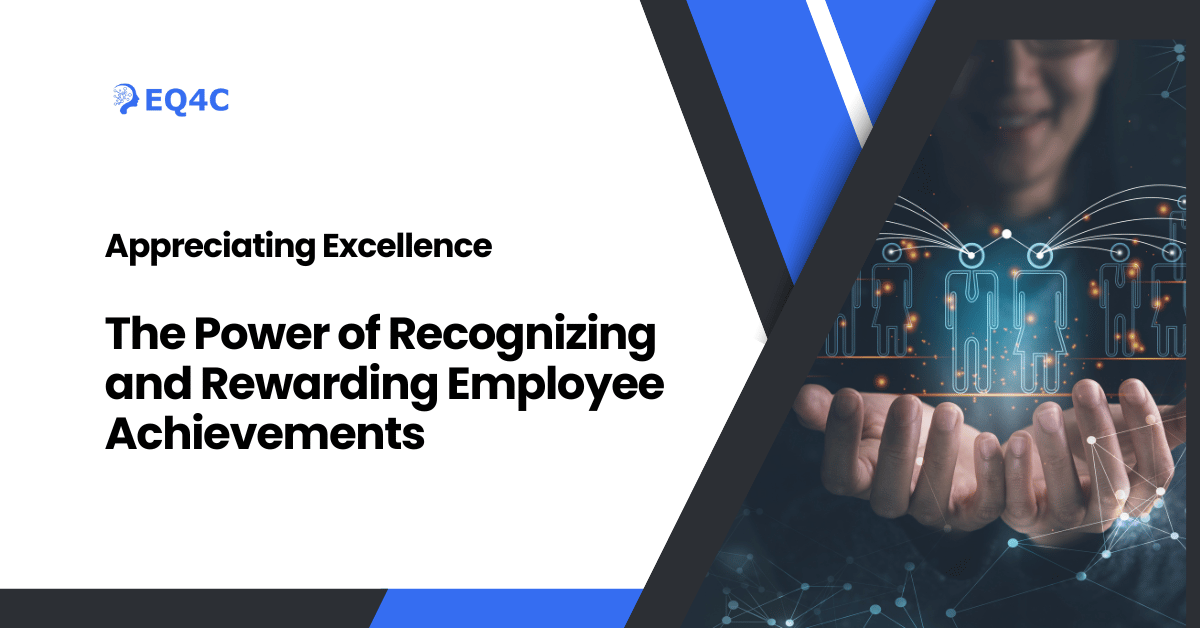Appreciating Excellence: The Power of Recognizing and Rewarding Employee Achievements

Employee motivation is the driving force behind the success of any organization.
Motivated employees are more productive, creative, loyal, and satisfied with their work. They are willing to go the extra mile to achieve the organizational goals and vision.
According to a study by Gallup, highly engaged teams show 21% greater profitability, 17% higher productivity, and 10% higher customer ratings than their counterparts.
Employee motivation is not only beneficial for the organization, but also for the individual employees, as it enhances their personal and professional growth, well-being, and happiness.
The role of recognition and rewards in boosting employee morale and engagement
One of the most effective ways to motivate employees is to recognize and reward their achievements.
Recognition and rewards are powerful tools to show appreciation, gratitude, and respect for the employees’ contributions and efforts.
They also reinforce the desired behaviors and outcomes that align with the organizational values and culture. Recognition and rewards can take various forms, such as verbal praise, public acknowledgment, certificates, trophies, bonuses, gifts, or career opportunities.
The key is to make them timely, specific, meaningful, and fair. According to a survey by O.C. Tanner, 79% of employees who quit their jobs cite a lack of appreciation as a key reason. On the other hand, 69% of employees say they would work harder if they felt their efforts were better recognized.
As a leader or an organization, you must understand that recognition and rewards not only increase employee motivation, but also employee morale and engagement, which are essential for creating a positive and supportive work environment.
The Psychology of Recognition and Rewards
Employee behavior is influenced by two types of motivators: intrinsic and extrinsic.
Intrinsic motivators are the internal factors that make an employee enjoy their work, such as interest, passion, curiosity, challenge, autonomy, mastery, and purpose.
Extrinsic motivators are the external factors that make an employee perform their work, such as salary, benefits, bonuses, promotions, feedback, recognition, and rewards.
Both types of motivators are important for employee motivation, but they have different effects on employee behavior. Intrinsic motivators tend to increase employee creativity, innovation, and commitment, while extrinsic motivators tend to increase employee compliance, productivity, and quality.
However, extrinsic motivators can also undermine intrinsic motivators if they are perceived as controlling, coercive, or unfair. Therefore, it is essential to balance the use of intrinsic and extrinsic motivators to optimize employee behavior.
For more details on the secrets of employee motivation, you can read our article on Unveiling the Secrets of Employee Motivation: Strategies for Igniting Passion and Productivity.
Recognizing the impact of recognition and rewards on job satisfaction and performance
Recognition and rewards are forms of extrinsic motivators that can have a positive impact on employee job satisfaction and performance.
Job satisfaction is the degree to which an employee is happy with their work and work environment. Performance is the degree to which an employee meets or exceeds the expectations and standards of their work.
- Recognition and rewards can enhance job satisfaction and performance by fulfilling some of the basic psychological needs of employees, such as competence, relatedness, and esteem.
- Recognition and rewards can also increase employee motivation, morale, and engagement, which are key factors for job satisfaction and performance.
- Recognition and rewards can also improve employee retention, loyalty, and advocacy, which are beneficial for the organization’s reputation and growth. However, recognition and rewards can also have a negative impact on job satisfaction and performance if they are not implemented properly.
- Recognition and rewards should be aligned with the organizational goals and values, consistent with the employee performance and behavior, and tailored to the employee preferences and needs.
Otherwise, recognition and rewards can cause employee dissatisfaction, resentment, and demotivation.
Therefore, it is important to design and deliver recognition and rewards in a way that maximizes their positive impact and minimizes their negative impact on job satisfaction and performance.
Effective Recognition and Reward Strategies
To make the most of recognition and rewards, it is important to follow some best practices and strategies that can enhance their effectiveness and impact.
Based on collective experience of EQ4C team, we have listed some of the key strategies that can help you create a successful recognition and reward program for your organization:
Implementing a structured recognition program aligned with organizational values
A structured recognition program is a formal and systematic way of acknowledging and rewarding employee achievements and behaviors that support the organizational values and goals.
A structured recognition program can have various components, such as:
- A clear and consistent criteria for recognition and rewards, based on the organizational values, culture, and objectives
- A variety of recognition and reward types, such as monetary, non-monetary, social, or developmental
- A transparent and fair process for nomination, selection, and distribution of recognition and rewards
- A regular and frequent schedule for recognition and rewards, such as weekly, monthly, quarterly, or annually
- A communication and promotion plan for recognition and rewards, such as newsletters, intranet, social media, or events
A well thought recognition program can help you achieve multiple benefits, such as:
- Aligning employee behavior and performance with the organizational values and goals
- Creating a culture of recognition and appreciation across the organization
- Enhancing employee motivation, morale, and engagement
- Improving employee retention, loyalty, and advocacy
- Boosting employee productivity, quality, and innovation
Tailoring rewards to individual preferences and contributions
One size does not fit all when it comes to recognition and rewards. Different employees have different preferences and needs for recognition and rewards, depending on their personality, values, interests, and goals.
Therefore, it is important to tailor rewards to individual preferences and contributions, to make them more meaningful and relevant for the employees. Some of the ways to tailor rewards to individual preferences and contributions are:
- Asking employees about their preferred recognition and reward types, such as cash, gift cards, vouchers, experiences, or learning opportunities
- Matching rewards to employee contributions, such as giving higher rewards for higher achievements or efforts
- Personalizing rewards to employee interests, hobbies, or passions, such as giving tickets to a concert, a book, or a subscription to a service
- Customizing rewards to employee needs, such as giving flexible work hours, paid leave, or health benefits
- Adding a personal touch to rewards, such as writing a handwritten note, giving a personalized card, or making a phone call
Tailoring rewards to individual preferences and contributions can help you achieve multiple benefits, such as:
- Increasing employee satisfaction and happiness with recognition and rewards
- Showing respect and appreciation for employee diversity and individuality
- Strengthening employee trust and relationship with the organization
- Encouraging employee ownership and responsibility for their work
- Inspiring employee growth and development
Utilizing timely and specific recognition for maximum impact
Timing and specificity are two crucial factors that can determine the impact of recognition and rewards on employee behavior and performance. Timely and specific recognition and rewards can have a positive impact, while delayed and vague recognition and rewards can have a negative impact. Therefore, it is important to utilize timely and specific recognition and rewards for maximum impact. Some of the ways to utilize timely and specific recognition and rewards are:
- Giving recognition and rewards as soon as possible after the employee achievement or behavior, such as within a day, a week, or a month
- Giving recognition and rewards in a timely manner, such as before the next performance review, project deadline, or goal setting
- Giving recognition and rewards in a specific manner, such as stating the exact achievement or behavior, the impact on the organization, and the appreciation for the employee
- Giving recognition and rewards in a specific context, such as in front of the team, the department, the organization, or the customer
- Giving recognition and rewards in a specific format, such as in a verbal, written, or visual form
Utilizing timely and specific recognition and rewards can help you achieve multiple benefits, such as:
- Reinforcing the desired employee achievement or behavior
- Providing feedback and guidance for employee improvement
- Increasing employee confidence and self-esteem
- Creating a sense of urgency and excitement for employee work
- Building a positive and supportive work environment
Recognition and rewards are powerful tools to motivate employees and achieve organizational goals. However, they are not the only tools. According to Herzberg’s Two-Factor Theory of Motivation, recognition and rewards are part of the hygiene factors, which are necessary but not sufficient for employee motivation. To truly motivate employees, you also need to provide them with the motivator factors, such as challenging work, autonomy, responsibility, growth, and achievement.
By combining recognition and rewards with the motivator factors, you can create a holistic and sustainable approach to employee motivation.
Unique and Engaging Recognition Ideas
Recognition and rewards can be more than just cash or certificates. They can also be creative, fun, and memorable experiences that make employees feel valued and appreciated.
We have followed some examples of unique and engaging recognition ideas from real-life case studies of successful organizations:
Heineken: BREWards
Heineken, a popular beer manufacturer, revamped its reward and recognition program to make it more inclusive, diverse, and frequent. The program, named BREWards, featured multiple levels of awards to recognize different levels of achievement and a variety of award experiences, such as:
- Cheers! instant awards of $65 for employees who demonstrate the company values of passion, enjoyment, respect, and quality
- Inspiring People Awards (IPAs) for employees who go above and beyond their roles and have a significant impact on the business or the community. IPAs can reward employees with a day off work, a dinner at one of Heineken’s breweries, or monetary rewards ranging from $100-$1000
- Star Awards for employees who achieve exceptional results or demonstrate outstanding leadership. Star Awards can reward employees with a trip to Amsterdam, the home of Heineken, or a donation to a charity of their choice
The program also integrated recognition and rewards into a single online platform, where employees can nominate, vote, and celebrate their peers, as well as access employee discounts and benefits. The program resulted in a 50% increase in the number of employees recognized by their peers and a 30% increase in the positive response to the question “I receive recognition when I do a good job” in the annual engagement survey1.
H&M: Xoxoday Plum
H&M, a global fashion retailer, partnered with Xoxoday Plum, a digital rewards platform, to enrich its rewards and recognition program and increase employee engagement and retention. The program offered employees a wide range of rewards to choose from, such as:
- Gift cards and vouchers from over 20,000 brands and merchants across 90 countries
- Experiences and activities, such as travel, wellness, entertainment, and adventure
- Donations to various causes and charities
- Learning and development opportunities, such as online courses, certifications, and subscriptions
The program also enabled employees to redeem their rewards instantly and conveniently through a mobile app or a web portal, where they can also view their reward history, balance, and expiry. The program also allowed managers and peers to send personalized messages and e-cards along with the rewards, to express their appreciation and gratitude. The program helped H&M to improve employee satisfaction, loyalty, and performance, as well as to reduce turnover and absenteeism2.
Reward Gateway: Employee Appreciation Week
Reward Gateway, an employee engagement software company, celebrated Employee Appreciation Week by organizing a series of events and activities to recognize and reward its employees for their hard work and dedication. The events and activities included:
- A virtual awards ceremony, where employees were nominated and recognized for various categories, such as innovation, collaboration, excellence, and impact. The winners received trophies, certificates, and gift cards
- A wellness day, where employees were encouraged to take a break from work and enjoy some self-care activities, such as yoga, meditation, massage, or reading. The company also provided employees with wellness kits, containing items such as candles, tea, and chocolate
- A trivia night, where employees formed teams and competed in a fun and interactive quiz, covering topics such as music, movies, sports, and culture. The winning team received a prize of $500 to donate to a charity of their choice
- A thank you wall, where employees could post messages and photos to thank and appreciate their colleagues for their support and collaboration. The wall was displayed on the company’s intranet and social media channels, creating a sense of community and belonging
The events and activities generated a lot of positive feedback and engagement from the employees, who felt valued, appreciated, and connected with their peers and managers3.
Conclusion
Today, we have explored the power of recognizing and rewarding employee achievements, and how it can boost employee motivation, engagement, and performance.
We have also discussed the psychology behind recognition and rewards, and how they can fulfill some of the basic human needs, such as competence, relatedness, and esteem.
Our team also shared some of the effective recognition and reward strategies that can help you create a successful recognition program for your organization.
We have learned some of the unique and engaging recognition ideas that can make your employees feel valued and appreciated.
Finally, we tried to explain how to measure the impact of recognition and rewards, and how to gather feedback from employees to refine and improve your recognition program.
We hope that this article has inspired you to create a culture of appreciation in your organization, and to recognize and reward your employees for their achievements and contributions.
Recognition and rewards are not only beneficial for the employees, but also for the organization, as they can enhance the organizational culture, reputation, and growth.
Recognition and rewards are also aligned with some of the popular motivation theories, such as Handy’s Motivation Theory, Alderfer’s ERG Theory of Motivation and Its Practical Applications, Sirota’s Three-Factor Theory of Employee Motivation and McClelland’s Human Motivation Theory, which suggest that employees are motivated by different factors, such as achievement, growth, equity, and affiliation.
However, recognition and rewards are not a one-time event, but a continuous process that requires constant monitoring and improvement.
You need to keep track of the employee engagement, satisfaction, and performance indicators, and see if they are improving as a result of recognition and rewards.
Gather feedback from employees, and see if they are happy and satisfied with recognition and rewards.
Update and adapt your recognition and reward strategies, and see if they are relevant and effective for your organization and employees.
Recognition and rewards are powerful tools to appreciate excellence and to motivate employees to perform at their best.
By implementing a recognition and reward program that is aligned with your organizational values and goals, and that is tailored to your employee preferences and needs, you can create a positive and supportive work environment that can drive organizational success.
We hope that you have enjoyed reading this article and learned something new and useful about recognition and rewards. If you want to learn more about employee motivation and engagement, you can visit our website and read some of our helpful articles, tools, tips and tricks.
Thank you for reading this article and for your interest in our website. We appreciate your feedback and comments, and we look forward to hearing from you soon.
Have a great day! 😊




